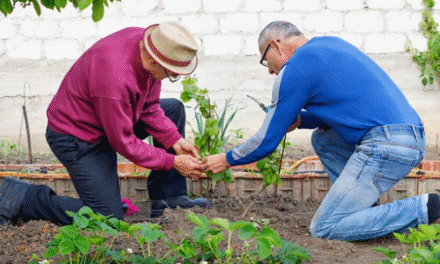Diane Beddison
I hope you all had some relaxation over summer. Once the heat of summer is gone, there is plenty to do in the garden. Now is the time to feed your plants, top up mulch, lightly prune autumn flowering plants and fill in the gaps in your garden or even start a new project.
Hepburn Shire has had a very dry summer so make sure to water your plants consistently. Take special care of plants which are still flowering such as roses and those which will be flowering soon, such as Camellias. Let’s hope for some autumn rains.
Feed your exotic plants with a general organic plant fertiliser. Australian native plants have adapted to our soils and require a specialised food which is low in phosphorus. Banksias and grevilleas are particularly phosphorus sensitive. Top up mulch in your vegetable patch and in herb and ornamental gardens.
If you don’t have a wicking bed, consider building or purchasing one now for herbs or vegetables. If you are buying a small one off the shelf, choose one with wheels so you can move it to where the light is just right for each season.
While there is still plenty of warmth in the soil, it’s a great time to plant. Your plants will get a head start for coping with next summer. New plants should be watered in well. Make sure to check them regularly as it may still be hot and water them as needed.
Choosing a deciduous tree or two for your garden? Be quick to check out trees as they move from their normal leaf colour to their autumn colour. Look at local gardens and in nurseries to select suitable trees. Your local nursery will have the expertise to assist customers make the right choices.
However, always remember to plan your garden, rather than rushing out and buying what looks nice that day.
Considerations for gardening near bushland
Avoid planting invasive weeds in your garden as they can easily escape into the native bush. While exotic plants are the major problem, certain non-indigenous natives can also cause issues. Some plants to avoid are lantana, periwinkle, for-get-me-not, gazania, and fountain grass. Non-local species that multiply quickly, such as wattles and hybrid grevilleas that seed profusely, are problematic (Jill Teschendorff , Grow Wild: Gardening to Sustain Wildlife in the Hepburn Shire, page 34).
If you are vulnerable to bush fires, don’t leave rubbish lying around. Dispose of dead plants and branches.
March can still be hot so mulch areas of bare soil in your garden. Mulch with granitic sand or gravel near the house as organic mulch will burn in a fire. You can also use these products to create lovely organic and cost-effective paths. Install toppings, gravel or granitic sand on a level crushed rock base and compact with a roller or similar.
Plant deciduous trees near your house rather than trees that burn easily. Always consider what size they will be in 20 years to determine if they are appropriate for your garden. Select the right location based on the trees needs and what you want to use them for (e.g. providing shade from northern or western sun). Make sure you don’t have a large gum tree or pine tree close to your house.
Plant of the Month
Ginkgo biloba is one of my favourite trees and is one of the first to change colour in autumn to a soft but warm yellow. Ginkgo are very resistant to disease and insect damage. They cope well in most areas of Victorian climates and now come in sizes to suit any garden. Plant a male Gingko as a feature or avenue tree.
The Ginkgo biloba is one of the oldest living tree species in the world. It’s the sole survivor of an ancient group of trees that date back to before dinosaurs roamed the Earth – creatures that lived between 245 and 66 million years ago. It’s so ancient, the species is known as a ‘Living fossil’. Fossils of Ginkgo leaves have been discovered that date back more than 200 million years. They are almost identical to maidenhair tree leaves of today.
Enjoy Autumn in the Garden.
Diane Beddison is a frequent visitor to Daylesford and the Principal of Beddison Garden Designs.





